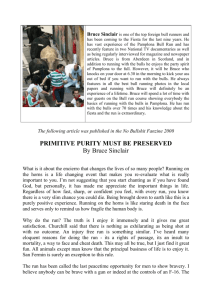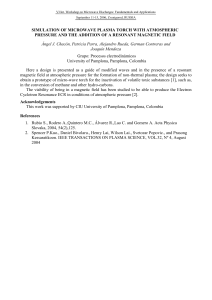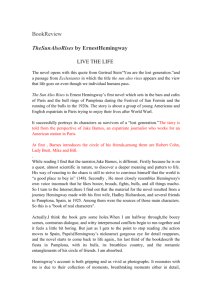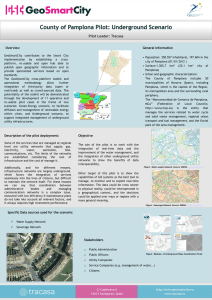Smithsonian.com Pamplona: No Bull
advertisement
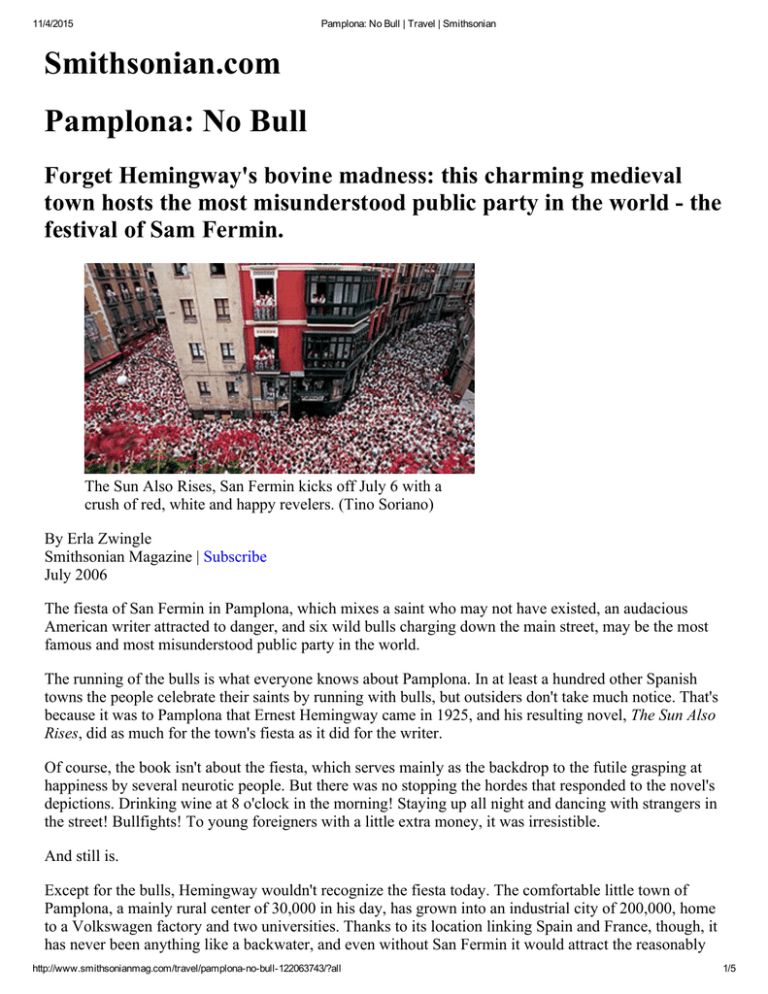
11/4/2015 Pamplona: No Bull | Travel | Smithsonian Smithsonian.com Pamplona: No Bull Forget Hemingway's bovine madness: this charming medieval town hosts the most misunderstood public party in the world ­ the festival of Sam Fermin. The Sun Also Rises, San Fermin kicks off July 6 with a crush of red, white and happy revelers. (Tino Soriano) By Erla Zwingle Smithsonian Magazine | Subscribe July 2006 The fiesta of San Fermin in Pamplona, which mixes a saint who may not have existed, an audacious American writer attracted to danger, and six wild bulls charging down the main street, may be the most famous and most misunderstood public party in the world. The running of the bulls is what everyone knows about Pamplona. In at least a hundred other Spanish towns the people celebrate their saints by running with bulls, but outsiders don't take much notice. That's because it was to Pamplona that Ernest Hemingway came in 1925, and his resulting novel, The Sun Also Rises, did as much for the town's fiesta as it did for the writer. Of course, the book isn't about the fiesta, which serves mainly as the backdrop to the futile grasping at happiness by several neurotic people. But there was no stopping the hordes that responded to the novel's depictions. Drinking wine at 8 o'clock in the morning! Staying up all night and dancing with strangers in the street! Bullfights! To young foreigners with a little extra money, it was irresistible. And still is. Except for the bulls, Hemingway wouldn't recognize the fiesta today. The comfortable little town of Pamplona, a mainly rural center of 30,000 in his day, has grown into an industrial city of 200,000, home to a Volkswagen factory and two universities. Thanks to its location linking Spain and France, though, it has never been anything like a backwater, and even without San Fermin it would attract the reasonably http://www.smithsonianmag.com/travel/pamplona­no­bull­122063743/?all 1/5 11/4/2015 Pamplona: No Bull | Travel | Smithsonian curious traveler. The first people, warlike Vascons, settled here as early as 1000 b.c.: they called it "Iruna," meaning "the city," as their Basque descendants still do. In 75 b.c. the Roman general Cnaeus Pompeius Magnus established a Roman town on the previous settlement, exploiting its strategic position and honoring it with his name, "Pompaelo." As the capital of the Kingdom of Navarre, which stretched across the Pyrenees into France, medieval Pamplona flourished on both commercial traffic and that of Christian pilgrims headed for Santiago de Compostela; the stern Gothic churches of San Saturnino and San Nicolas still brim with ecclesiastical treasures. And three­quarters of the Renaissance fortifications of the old city remain, making Pamplona's massive walls among the best­preserved defenses in Spain. But it's the fiesta that people come for, and every year from July 6 to 14, Pamplona is inundated by a kind of storm surge of revelers. Over nine days, one and a half million people pass through, every one of them seemingly heading for the historic center of town, an area of about two square miles. Only a few come for more than two or three days, but the flow is incessant. "Fiesta" doesn’t begin to cover the event's scope. It's more like a biblical visitation, a triathlon with music, for which the town provides medical emergency squads on 24­hour alert, thousands of volunteers to clean the streets of tons of garbage, extra police patrols and temporary toilets. Pamplonans who can't take it pack up and leave town. Still, there are many who stay, and not because they have to. They adore their fiesta and live it with their whole hearts despite the chaos. Visitors "all think from the outside looking in that the fiesta is all about drinking and staying up all night, but it's not," said native Pamplonan Nekane Arrizibita, 38. In fact, if you filter out the foreigners and focus on the locals, you discover a fiesta that's hidden in plain view: laughing children, tranquil grandparents, groups of various ages sharing a happiness that has nothing to do with drinking themselves senseless, sleeping on the grass or running with the bulls. It's about forgetting the rules, declaring a sort of invisible social cease­fire that allows everyone to be spontaneous once a year without fear of repercussion—a sense of freedom that can be appreciated only by people who live their entire life in a conservative, religious town in conservative, religious northern Spain. "Almost everyone here knows you, or knows someone who knows you," explained Eduardo Arregui, a 31­year­old telecommunications engineer. "It's not easy doing crazy things when you know that someone you know can see you. But during San Fermin, there's a kind of green light for almost everything. It's like you’ve put on a mask. You're not yourself anymore but the person you want to be." Pamplonans, he continued, "don't think of drinking and dancing and partying as the fiesta, but as the background of the fiesta—the fiesta each person lives inside of themselves." It starts with a bang—30 of them, a succession of rockets fired from the balcony of the Casa Consistorial, or Town Hall, at noon on July 6, accompanied by a rain of red and white streamers and confetti. Called Txupinazo, this is the official launch of the festivities. Below, in the plaza, a packed crowd somehow manages to spray wild deluges of cheap champagne everywhere. (Photographers shooting pictures out of windows even three stories up know to wrap themselves in typhoon­proof plastic.) Most everyone ties a red bandanna around his neck, the town band begins to play traditional Basque songs, and roars of pleasure compete with the sounds of rockets overhead. Of course it is all going to end in tears—204 hours later, to be precise, at midnight July 14, when many of the same people will meet again at the same place for the closing ceremony, the "Pobre de mi.'" They will untie their red bandannas, hold candles and sing mournfully, "Poor me, poor me, the fiesta has come to an end...." But nobody is thinking about that now. The hordes fan out across the center of town, gamboling across granite streets slick with beer, champagne and sweat. Before long blood is added to the mix, as revelers carouse amid 30 tons of mostly broken bottles in the square. Everywhere there's noise, from the charangas, the brass bands of the irrepressible social clubs known as penas, to the throbbing hypnotic notes of the txalparta, a Basque mountain instrument made of slabs of cherry, acacia and beechwood, played like a heavy timber xylophone, to live concerts, fireworks, people singing, children crying, high­ http://www.smithsonianmag.com/travel/pamplona­no­bull­122063743/?all 2/5 11/4/2015 Pamplona: No Bull | Travel | Smithsonian power hoses spraying the street clean, the occasional siren. While tourists, many already well oiled, head for the stone pillar in the St. Cecilia fountain to jump from it into the arms—they hope—of waiting mates, Pamplonans are gathering for festive lunches. In restaurants throughout the city, tables reserved months ahead fill with clans dressed in traditional garb of red and white, two Basque customary colors that represent the blood shed in the struggle for independence and the Catholic faith. Through the cigar smoke a cheer will suddenly rise: "¡Viva San Fermin!" And everyone responds "¡Viva!" And again, in Basque: "¡Gora San Fermin!" "¡GORA!" At 7:00 each morning of the nine­day fiesta, squads of men start to set up wooden barriers along the path of the encierro, the daily running of the bulls. On this particular day as many as 6,000 runners, mostly men above the official minimum age of 18, have chanted the traditional prayer to San Fermin three times for protection and have positioned themselves at various points along the stretch of streets from the bullpen to the Plaza de Toros, where the animals will be shunted into stalls to await the evening's corrida, or bullfight. Thousands of onlookers cling to the barriers, and every window and balcony overlooking the route is crammed with even more spectators, many of whom have paid handsomely for the view. At 8:00 a.m., a rocket signals that the six bulls have burst from the holding pen and are on their way. Why bulls, and why are they running? Religious rituals have often required an animal sacrifice; here the bullfight has taken over this role. The bulls have always been driven through town to the bullring, and running in front of them probably began spontaneously. To show courage, or to show one's faith in the saint's protection, once had real importance. For some today it still does. The bulls cover the half­mile distance in about two minutes; there are points at which the beasts have been clocked at speeds faster than an Olympic sprinter. Runners have to choose which section of street they want to run, because they'll be with the bulls for only about ten yards. At street level it is all hugely anticlimactic (unless you happen to be at the spot where a runner makes a mistake). If you manage to see anything besides a mob of other people, you will glimpse the bulls for about three seconds. To a runner, of course, it's something else entirely. "It's adrenaline over the top," said Eduardo Arregui, the young engineer, who has run the encierro every year for nearly half his life. "One or two months before San Fermin, I start thinking about the bulls, and I feel my heart pumping, and sweating. As the moment comes closer, it gets worse." And then? "When the rocket goes off," says Mikel Aranburu, a tax assessor who teaches the Basque flute, "the fear goes away and everything goes blank. And when the bulls pass by, you feel extreme relief. You feel exaltation, friendship, life. It's a very, very intense experience. You're hooked. It’s like a drug, and you're almost begging for more." But it's a drug that fewer and fewer locals care to try. "It used to be a rite of passage, an initiation, for the boys of Pamplona," Aranburu added. "Their fathers and grandfathers and elder brothers had run. So if you were 15 or 16 and you hadn't run the encierro, you weren't a man yet. But now because of the media, the encierro has changed from being a Pamplona thing to an international event. Now the boys of Pamplona don't have the same interest in it; they prefer socializing, drinking, smoking and hanging out." Most Pamplonans now watch it on TV. After the encierro, bars and restaurants fill up again, and the tumult on the blinding hot streets slows to a leisurely swarm. Mime artists find a spot of shade to continue their silent gesticulating, while makeshift stands offer plastic glasses of kalimotxo, a concoction of equal parts red wine and Coca­Cola. Habitués of the bar at the Hotel Yoldi favor shampu (lemon sorbet and champagne in real glasses). The drinks display an unusual touch of social distinction, but whatever your beverage, this would be a good moment to look for a shady bench along the tree­lined battlements and pause to reflect on a few themes. http://www.smithsonianmag.com/travel/pamplona­no­bull­122063743/?all 3/5 11/4/2015 Pamplona: No Bull | Travel | Smithsonian Religion, perhaps. Pamplona is a major center of Opus Dei, the conservative Catholic lay movement. And when, on July 7, San Fermin's relics are carried from his chapel in the Church of San Lorenzo to the Cathedral of Santa Maria for solemn high Mass, it's an emotional procession. But this is the only day religion rules; the rest of the week, San Fermin has to take his chances like everybody else. "San Fermin would be crying if he could see what's going on at his feast," Padre Jesus Labari, the parish priest of San Lorenzo told me. "There’s no sleep. And the odor of urine and dirt in the street." On the other hand, "the majority of people who come for the fiesta don't leave the city without visiting the saint, even if they're not believers. I’m no fool. I know that during the year a lot of them don't go to church. But every year there are more and more people who come to the procession. It's thrilling—the people really do cry when they see the saint pass by them." While the fiesta still retains elements that a jongleur or wandering friar would recognize—street performers, flashes of intense piety, that wild sense of freedom—many of its best­known customs are surprisingly recent. Several years ago, for example, children spontaneously offered a few flowers to San Fermin. Now an entire morning is devoted to the children and their flowers—red and white carnations, yellow roses, orange gladiolus—laced into a broad trellis behind the saint. Dressing in red and white began in the 1960s; before that, celebrants wore street clothes. The bulls used to run at 6:00 a.m., but since 1974, the time has crept ever later to today's 8:00 a.m. Even the Txupinazo began to take form only when people spontaneously began to set off rockets in the Plaza del Castillo, half a century ago. The last day of the fiesta is July 14. You can feel it seeping away. The music seems a little sadder, and people seem to move a little slower. Jeweler Marcial Acuna Lopez stands at Plaza San Nicolas, which tomorrow, like the whole city, will be empty of revelers. "Pamplona will seem like a spectacular painting that has been cut out of its frame and carried away under cover of darkness," he tells me. "When San Fermin is over, all you see is the frame. And it makes you think: during the fiesta, everybody talks to one another. The rest of the year everybody is very serious. Why aren't we always the way we are in San Fermin?" It's an excellent question of the kind no philosopher has been able to answer. Why can't we always be happy? Why do we have to grow up, get old, die? In Pamplona, during San Fermin, nobody asks such questions. And the only answer that makes any sense is that next year the fiesta will come again. Sun or Shadow? Where you sit in the bullring says it all Pamplona's bullring, inaugurated three years before Hemingway's first visit to Pamplona, is the second largest in Spain. Its 19,529 seats sell out far in advance, and scalping flourishes despite the efforts of police to stop it. The ring's shadow divides the spectators. Those in the shade tend to stare silently at the struggle below, analyzing the talent of the matador and the merits of the bull. Most of those in the sun are here to party, and if they care about what's going on below they are absolutely on the side of the bull. Members of social clubs called penas eat, drink, sing raucous scraps of song to the brassy accompaniment of their bands and, as the heat and booze begin to take their toll, start throwing things at each other: food, wine, pieces of ice from their coolers. "We're not concerned about the image we're projecting to the outside," said Fermin Paularena, a member of the Irrintzi pena. "We're concerned about having a good time." But no matter the side of the shadow line you find yourself in, it seems strange to http://www.smithsonianmag.com/travel/pamplona­no­bull­122063743/?all 4/5 11/4/2015 Pamplona: No Bull | Travel | Smithsonian hear a band blaring theme songs from American movies while a lone, slender man faces a lunging black silhouette that seems lifted intact from ancient cave drawings in Altamira, 175 miles away. It all comes together in an instant: the powerful impact of the bull's muscular ink­black shape against the blinding yellow of the sand, and the bull's mythic power, which gives off a primitive vibration of danger. The incongruity of the jaunty soundtrack with the voiceless drama of panting breath and dripping blood is one of San Fermin's most indelible impressions. —E.Z. Like this article? SIGN UP for our newsletter Email SIGN UP http://www.smithsonianmag.com/travel/pamplona­no­bull­122063743/?all 5/5

